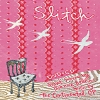 The first time I heard Continental OP, the collaborative projectbetween Dave Pajo and Will Oldham, was on the label Temporary ResidenceLimited's compilation called "Sounds For The GeographicallyChallenged." I bought that record largely because of Continental OP'sappearance on it (I had been tipped off who the band members were) and,after listening to the playful but underwhelming song, regarded theproject mostly as a lark, never expecting to see the collaborativeeffort turn up again. But five years later, team Pajoldham havesurprised me by offering a collection of songs which serve as thescore/soundtrack for an independent short film called "Slitch." Onceagain, the project seems like a lark, as if the two were doing thefilmmaker Dianne Bellino a nice favor, producing a little chestnut:nothing as fancy or remarkable as the Dashiell Hammett character theband's name references. There are springy melodic tracks ("Faster"),Misfits punk rock approximations ("James Tired"), and simplistic songswith second-grade-music-class-instrument accoutrements ("Glock"). Themost resonant song is "La La La," an infectious Free Design inspiredharmony line which I found myself humming throughout the day. All ofthese sort of limp ahead clumsily with no signature sound contributedby either Pajo or Oldham and without any real direction, which bringsus to the film itself. On the flip side of the DVD is Dianne Bellino'sshort film "Slitch." The word "slitch" is an amalgam of "slut" and"bitch," and it is the appellation which the protagonist's bitter oldersisters assign to her because she is distracted in her behavior, aloofin her interactions, and (according to the sisters) often carefreeabout her sexual encounters. At our first glimpse of Slitch, she islying in the grass of some wooded parkland, having ostensibly justslept with the man next to her. She arises with a noticeable glint inher eyes, retrieves her underwear from the shrubbery, and is off. Thefocal point of the film is Slitch's interactions with the local surferdude, played fondly by Will Oldham. Oldham's surfer is as oblivious toSlitch's sexual advancements as she is heavy-handed in their delivery.He just wants to watch surfing videos and surf, while she just wants tohave sex. At one point they compromise and have ice cream. Besidesobserving Oldham, which is always fun, I was delightfully distractedfrom the film by trying to determine if the beach where Bellino filmedwas the same Rhode Island beach where I had spent a Fourth of July onceand a pal of mine had lost his car keys in the sand (they were latermiraculously found in a last ditch effort, but not before I had lenthim $40 to have a new key made. We are both still uncertain if that $40was ever recouped by me). Formally, the film is carefully shot andconsidered. It even has moments of looking delicate, such as Slitch'ssunsetted stroll on the beach or Slitch's silent mom grabbing a MillerHi-Life from the refrigerator, but nothing very engaging in terms ofstory or plot. The film's story is an innocuous Cinderella tale with nosense of danger or drama. Slitch's two evil sisters seem no moreoppressive than a gaggle of noisy geese, and her Prince Charming wouldrather jet off to Hawaii than bother deciphering Slitch's confusingmind state. We are asked to believe that Slitch has an alarming needfor sex, but we never really see this. She does not habituallymasturbate; there are no erotic posters of Corey Haim on her walls; andshe seems able to occupy herself with placid walks on the beach at duskwhile listening to her walkman. Sex seems almost as a healthy avocationto her, not a destructive obsession. The evil sisters ought to relaxtheir criticism of Slitch and take a moment between moustache waxes tograb a beer with mom.
The first time I heard Continental OP, the collaborative projectbetween Dave Pajo and Will Oldham, was on the label Temporary ResidenceLimited's compilation called "Sounds For The GeographicallyChallenged." I bought that record largely because of Continental OP'sappearance on it (I had been tipped off who the band members were) and,after listening to the playful but underwhelming song, regarded theproject mostly as a lark, never expecting to see the collaborativeeffort turn up again. But five years later, team Pajoldham havesurprised me by offering a collection of songs which serve as thescore/soundtrack for an independent short film called "Slitch." Onceagain, the project seems like a lark, as if the two were doing thefilmmaker Dianne Bellino a nice favor, producing a little chestnut:nothing as fancy or remarkable as the Dashiell Hammett character theband's name references. There are springy melodic tracks ("Faster"),Misfits punk rock approximations ("James Tired"), and simplistic songswith second-grade-music-class-instrument accoutrements ("Glock"). Themost resonant song is "La La La," an infectious Free Design inspiredharmony line which I found myself humming throughout the day. All ofthese sort of limp ahead clumsily with no signature sound contributedby either Pajo or Oldham and without any real direction, which bringsus to the film itself. On the flip side of the DVD is Dianne Bellino'sshort film "Slitch." The word "slitch" is an amalgam of "slut" and"bitch," and it is the appellation which the protagonist's bitter oldersisters assign to her because she is distracted in her behavior, aloofin her interactions, and (according to the sisters) often carefreeabout her sexual encounters. At our first glimpse of Slitch, she islying in the grass of some wooded parkland, having ostensibly justslept with the man next to her. She arises with a noticeable glint inher eyes, retrieves her underwear from the shrubbery, and is off. Thefocal point of the film is Slitch's interactions with the local surferdude, played fondly by Will Oldham. Oldham's surfer is as oblivious toSlitch's sexual advancements as she is heavy-handed in their delivery.He just wants to watch surfing videos and surf, while she just wants tohave sex. At one point they compromise and have ice cream. Besidesobserving Oldham, which is always fun, I was delightfully distractedfrom the film by trying to determine if the beach where Bellino filmedwas the same Rhode Island beach where I had spent a Fourth of July onceand a pal of mine had lost his car keys in the sand (they were latermiraculously found in a last ditch effort, but not before I had lenthim $40 to have a new key made. We are both still uncertain if that $40was ever recouped by me). Formally, the film is carefully shot andconsidered. It even has moments of looking delicate, such as Slitch'ssunsetted stroll on the beach or Slitch's silent mom grabbing a MillerHi-Life from the refrigerator, but nothing very engaging in terms ofstory or plot. The film's story is an innocuous Cinderella tale with nosense of danger or drama. Slitch's two evil sisters seem no moreoppressive than a gaggle of noisy geese, and her Prince Charming wouldrather jet off to Hawaii than bother deciphering Slitch's confusingmind state. We are asked to believe that Slitch has an alarming needfor sex, but we never really see this. She does not habituallymasturbate; there are no erotic posters of Corey Haim on her walls; andshe seems able to occupy herself with placid walks on the beach at duskwhile listening to her walkman. Sex seems almost as a healthy avocationto her, not a destructive obsession. The evil sisters ought to relaxtheir criticism of Slitch and take a moment between moustache waxes tograb a beer with mom.  The first time I heard Continental OP, the collaborative projectbetween Dave Pajo and Will Oldham, was on the label Temporary ResidenceLimited's compilation called "Sounds For The GeographicallyChallenged." I bought that record largely because of Continental OP'sappearance on it (I had been tipped off who the band members were) and,after listening to the playful but underwhelming song, regarded theproject mostly as a lark, never expecting to see the collaborativeeffort turn up again. But five years later, team Pajoldham havesurprised me by offering a collection of songs which serve as thescore/soundtrack for an independent short film called "Slitch." Onceagain, the project seems like a lark, as if the two were doing thefilmmaker Dianne Bellino a nice favor, producing a little chestnut:nothing as fancy or remarkable as the Dashiell Hammett character theband's name references. There are springy melodic tracks ("Faster"),Misfits punk rock approximations ("James Tired"), and simplistic songswith second-grade-music-class-instrument accoutrements ("Glock"). Themost resonant song is "La La La," an infectious Free Design inspiredharmony line which I found myself humming throughout the day. All ofthese sort of limp ahead clumsily with no signature sound contributedby either Pajo or Oldham and without any real direction, which bringsus to the film itself. On the flip side of the DVD is Dianne Bellino'sshort film "Slitch." The word "slitch" is an amalgam of "slut" and"bitch," and it is the appellation which the protagonist's bitter oldersisters assign to her because she is distracted in her behavior, aloofin her interactions, and (according to the sisters) often carefreeabout her sexual encounters. At our first glimpse of Slitch, she islying in the grass of some wooded parkland, having ostensibly justslept with the man next to her. She arises with a noticeable glint inher eyes, retrieves her underwear from the shrubbery, and is off. Thefocal point of the film is Slitch's interactions with the local surferdude, played fondly by Will Oldham. Oldham's surfer is as oblivious toSlitch's sexual advancements as she is heavy-handed in their delivery.He just wants to watch surfing videos and surf, while she just wants tohave sex. At one point they compromise and have ice cream. Besidesobserving Oldham, which is always fun, I was delightfully distractedfrom the film by trying to determine if the beach where Bellino filmedwas the same Rhode Island beach where I had spent a Fourth of July onceand a pal of mine had lost his car keys in the sand (they were latermiraculously found in a last ditch effort, but not before I had lenthim $40 to have a new key made. We are both still uncertain if that $40was ever recouped by me). Formally, the film is carefully shot andconsidered. It even has moments of looking delicate, such as Slitch'ssunsetted stroll on the beach or Slitch's silent mom grabbing a MillerHi-Life from the refrigerator, but nothing very engaging in terms ofstory or plot. The film's story is an innocuous Cinderella tale with nosense of danger or drama. Slitch's two evil sisters seem no moreoppressive than a gaggle of noisy geese, and her Prince Charming wouldrather jet off to Hawaii than bother deciphering Slitch's confusingmind state. We are asked to believe that Slitch has an alarming needfor sex, but we never really see this. She does not habituallymasturbate; there are no erotic posters of Corey Haim on her walls; andshe seems able to occupy herself with placid walks on the beach at duskwhile listening to her walkman. Sex seems almost as a healthy avocationto her, not a destructive obsession. The evil sisters ought to relaxtheir criticism of Slitch and take a moment between moustache waxes tograb a beer with mom.
The first time I heard Continental OP, the collaborative projectbetween Dave Pajo and Will Oldham, was on the label Temporary ResidenceLimited's compilation called "Sounds For The GeographicallyChallenged." I bought that record largely because of Continental OP'sappearance on it (I had been tipped off who the band members were) and,after listening to the playful but underwhelming song, regarded theproject mostly as a lark, never expecting to see the collaborativeeffort turn up again. But five years later, team Pajoldham havesurprised me by offering a collection of songs which serve as thescore/soundtrack for an independent short film called "Slitch." Onceagain, the project seems like a lark, as if the two were doing thefilmmaker Dianne Bellino a nice favor, producing a little chestnut:nothing as fancy or remarkable as the Dashiell Hammett character theband's name references. There are springy melodic tracks ("Faster"),Misfits punk rock approximations ("James Tired"), and simplistic songswith second-grade-music-class-instrument accoutrements ("Glock"). Themost resonant song is "La La La," an infectious Free Design inspiredharmony line which I found myself humming throughout the day. All ofthese sort of limp ahead clumsily with no signature sound contributedby either Pajo or Oldham and without any real direction, which bringsus to the film itself. On the flip side of the DVD is Dianne Bellino'sshort film "Slitch." The word "slitch" is an amalgam of "slut" and"bitch," and it is the appellation which the protagonist's bitter oldersisters assign to her because she is distracted in her behavior, aloofin her interactions, and (according to the sisters) often carefreeabout her sexual encounters. At our first glimpse of Slitch, she islying in the grass of some wooded parkland, having ostensibly justslept with the man next to her. She arises with a noticeable glint inher eyes, retrieves her underwear from the shrubbery, and is off. Thefocal point of the film is Slitch's interactions with the local surferdude, played fondly by Will Oldham. Oldham's surfer is as oblivious toSlitch's sexual advancements as she is heavy-handed in their delivery.He just wants to watch surfing videos and surf, while she just wants tohave sex. At one point they compromise and have ice cream. Besidesobserving Oldham, which is always fun, I was delightfully distractedfrom the film by trying to determine if the beach where Bellino filmedwas the same Rhode Island beach where I had spent a Fourth of July onceand a pal of mine had lost his car keys in the sand (they were latermiraculously found in a last ditch effort, but not before I had lenthim $40 to have a new key made. We are both still uncertain if that $40was ever recouped by me). Formally, the film is carefully shot andconsidered. It even has moments of looking delicate, such as Slitch'ssunsetted stroll on the beach or Slitch's silent mom grabbing a MillerHi-Life from the refrigerator, but nothing very engaging in terms ofstory or plot. The film's story is an innocuous Cinderella tale with nosense of danger or drama. Slitch's two evil sisters seem no moreoppressive than a gaggle of noisy geese, and her Prince Charming wouldrather jet off to Hawaii than bother deciphering Slitch's confusingmind state. We are asked to believe that Slitch has an alarming needfor sex, but we never really see this. She does not habituallymasturbate; there are no erotic posters of Corey Haim on her walls; andshe seems able to occupy herself with placid walks on the beach at duskwhile listening to her walkman. Sex seems almost as a healthy avocationto her, not a destructive obsession. The evil sisters ought to relaxtheir criticism of Slitch and take a moment between moustache waxes tograb a beer with mom. 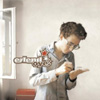 With the undeniable hit that the Kings of Convenience Remixesalbum became, it's unsurprising that the next move from singer ErlendØye was to continue on the electronic music path, employing theservices of many, leaving the acoustic guitar tunesmith days to liedormant. Unrest features ten songs, each with a differentelectronic music collaborator, each taking place in a different city.The concept is appealing for those who found some of thereconstructions and reworkings a spectacular accomplishment, as theinfluences of outside collaborators and remixers had a marvelouseffect. Without the tinkling guitars and folky vocals serving the basisfor the tunes, the truly unique identity is somewhat lost. While thesongs are somewhat catchy, like the fast-talking (almost rapping)"Prego Amore" with Jolly Music, the opener "Ghost Trains" with MorganGeist of New York and the discoey beats of "Sudden Rush" with Kompis,this album could honestly be another drop in the bucket in the trend ofnew techno pop, popularized by Morr related artists, The PostalService, and others. The most exciting direction unsurprisingly comesfrom Prefuse 73, who has integrated a number of horn, vibe, and guitarsounds into the mix, but only ever subtly and not tampering with theelectronic bass sound that drives the rest of the music. For the restof the record, it's a lot of tired drum machine sounds, sparseinstrumentation, and unchallenging vocals.
With the undeniable hit that the Kings of Convenience Remixesalbum became, it's unsurprising that the next move from singer ErlendØye was to continue on the electronic music path, employing theservices of many, leaving the acoustic guitar tunesmith days to liedormant. Unrest features ten songs, each with a differentelectronic music collaborator, each taking place in a different city.The concept is appealing for those who found some of thereconstructions and reworkings a spectacular accomplishment, as theinfluences of outside collaborators and remixers had a marvelouseffect. Without the tinkling guitars and folky vocals serving the basisfor the tunes, the truly unique identity is somewhat lost. While thesongs are somewhat catchy, like the fast-talking (almost rapping)"Prego Amore" with Jolly Music, the opener "Ghost Trains" with MorganGeist of New York and the discoey beats of "Sudden Rush" with Kompis,this album could honestly be another drop in the bucket in the trend ofnew techno pop, popularized by Morr related artists, The PostalService, and others. The most exciting direction unsurprisingly comesfrom Prefuse 73, who has integrated a number of horn, vibe, and guitarsounds into the mix, but only ever subtly and not tampering with theelectronic bass sound that drives the rest of the music. For the restof the record, it's a lot of tired drum machine sounds, sparseinstrumentation, and unchallenging vocals.- Ghost Trains (with Morgan Geist)
- Like Gold (with Schneider TM)
- Prego Amore (with Jolly Music)
 Via Tania is the project of ex-Spdfgh bassist/vocalist and Australian nativeTania Bowers in a very relaxed, groove-oriented setting as asinger/songwriter. Those familiar with the musical happenings in the Chicagoscene over the last few years may recognize her from adding guest vocals ondiscs by various artists. On her six-song debut solo EP, engineered by acesoundman Casey Rice (Designer), Dream Of... brings in some very coolinstrumental backing from Tortoise/Isotope 217 members John Herndon on drumsand Jeff Parker on guitar, and also enlists Scott Herren (Prefuse 73, Savath+ Savalas) and While to provide a couple of remixes. The three minute, verylaid back "Little China" showcases Bowers beautiful voice, which arrives attimes very delicately, over solid bass, soft drums, and full, jazzy guitarchords. "Fighter" opens with a series of distant guitar overdubs which statethe chord progressions and melody, only to gradually fade out and introduceupright bass and brushed drums and sultry vocals which carry the tune."Mosquito Lights" is a haunting ballad comprised of dark, thick and minorsounding piano chord progressions and multi-tracked vocals which appear tosing of loss. The breathy vocals and overall vibe of the track "UniverseCity" come through twice on the EP; the second time as a remix by While.This version, the longest track on the disc at just under six minutes, isanchored by a very low-end sliding synth bass line, mechanical percussionand sampled woodwinds which give it a real heavy chill-out vibe. Running atjust over twenty-five minutes, this EP makes for a great introduction forBowers' blend of laid back pop, her full-length disc Under A DifferentSky and also as an artist to watch for.
Via Tania is the project of ex-Spdfgh bassist/vocalist and Australian nativeTania Bowers in a very relaxed, groove-oriented setting as asinger/songwriter. Those familiar with the musical happenings in the Chicagoscene over the last few years may recognize her from adding guest vocals ondiscs by various artists. On her six-song debut solo EP, engineered by acesoundman Casey Rice (Designer), Dream Of... brings in some very coolinstrumental backing from Tortoise/Isotope 217 members John Herndon on drumsand Jeff Parker on guitar, and also enlists Scott Herren (Prefuse 73, Savath+ Savalas) and While to provide a couple of remixes. The three minute, verylaid back "Little China" showcases Bowers beautiful voice, which arrives attimes very delicately, over solid bass, soft drums, and full, jazzy guitarchords. "Fighter" opens with a series of distant guitar overdubs which statethe chord progressions and melody, only to gradually fade out and introduceupright bass and brushed drums and sultry vocals which carry the tune."Mosquito Lights" is a haunting ballad comprised of dark, thick and minorsounding piano chord progressions and multi-tracked vocals which appear tosing of loss. The breathy vocals and overall vibe of the track "UniverseCity" come through twice on the EP; the second time as a remix by While.This version, the longest track on the disc at just under six minutes, isanchored by a very low-end sliding synth bass line, mechanical percussionand sampled woodwinds which give it a real heavy chill-out vibe. Running atjust over twenty-five minutes, this EP makes for a great introduction forBowers' blend of laid back pop, her full-length disc Under A DifferentSky and also as an artist to watch for.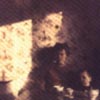 Like many current serious artists, Hajsch—who's work lies somewherebetween experimental electronic, electro-acoustic and musicconcrete—tries to break free from categorization. This remasteredreissue of two limited vinyl only albums originally released in 1992 (Nagual and PFN - Hajsch and collaborators)on his own Quiet Artworks label sound both contemporary andchallenging, thirteen years later. "Akasa" is a quiet but intenseopener: a 16 minute journey starting off with concrete sounds,synthesizers and field recordings which build up an electrifyingatmosphere slowly that finally reaches it's peak when an almostorchestral ensemble of viola, cello and clarinet appears. "Nagual (Part1)" takes use of sharp contrasts, with sparkling water morning birds,bound in a nearly dream-like atmosphere. Parts one and two consistmainly of sounds taken from a bicycle, melodica, and a hardlyrecognizable guitar. In "Nagual (Part 2)" the mood changes to a moreunsettling ambience. For those who've read Carlos Castaneda,this shouldn't be unexpected, as the concept of Nagual stands contraryto Tonal, that represents all our known territory, material andimmaterial. "Nagual (Part 3)" is an otherworldly, nearly harmonic shortappendix created only with synth and samples. "Für Cleo" is a pleasantcinema-like closer where a quiet guitar drone meets a melancholicsaxophone. Hajsch's music requests close attention and throws thelistener in an aural environmentof great clarity. His strength lies with the careful arrangement ofseldom heard sounds in the purposeful use of volume and timing. Thefact that these recordings are over 10 years old doesn't matter much,as 1992is stimulating, serious, and strong evidence that some music can betimeless no matter how styles and technical possibilities change.
Like many current serious artists, Hajsch—who's work lies somewherebetween experimental electronic, electro-acoustic and musicconcrete—tries to break free from categorization. This remasteredreissue of two limited vinyl only albums originally released in 1992 (Nagual and PFN - Hajsch and collaborators)on his own Quiet Artworks label sound both contemporary andchallenging, thirteen years later. "Akasa" is a quiet but intenseopener: a 16 minute journey starting off with concrete sounds,synthesizers and field recordings which build up an electrifyingatmosphere slowly that finally reaches it's peak when an almostorchestral ensemble of viola, cello and clarinet appears. "Nagual (Part1)" takes use of sharp contrasts, with sparkling water morning birds,bound in a nearly dream-like atmosphere. Parts one and two consistmainly of sounds taken from a bicycle, melodica, and a hardlyrecognizable guitar. In "Nagual (Part 2)" the mood changes to a moreunsettling ambience. For those who've read Carlos Castaneda,this shouldn't be unexpected, as the concept of Nagual stands contraryto Tonal, that represents all our known territory, material andimmaterial. "Nagual (Part 3)" is an otherworldly, nearly harmonic shortappendix created only with synth and samples. "Für Cleo" is a pleasantcinema-like closer where a quiet guitar drone meets a melancholicsaxophone. Hajsch's music requests close attention and throws thelistener in an aural environmentof great clarity. His strength lies with the careful arrangement ofseldom heard sounds in the purposeful use of volume and timing. Thefact that these recordings are over 10 years old doesn't matter much,as 1992is stimulating, serious, and strong evidence that some music can betimeless no matter how styles and technical possibilities change.  Coming from the school of two guitars, bass and drums, I like to think thatmy interest over the years for certain areas of experimental,electronic-based music has not only lead to a slightly better understandingof the genre but to also recognize and appreciate its more salient artisticqualities. As Antimatter, San Francisco-based sound artist and audioengineer, Xopher Davidson, has recently released a solo disc that plays outlike an aural sojourn to the gallery exhibit of cutting edge abstraction.>From a Powerbook-based standpoint Antimatter vs Antimatter is acollection of experimental soundscapes, frequencies, instrument manipulationand rhythmic collages. Knowing that Davidson holds an MFA could provide someinsight as to his approach when constructing and composing with varioussound textures. Spanning just over an hour, the disc's seventeen tracks areemotionally varied from beautiful and seductive to angry and powerful.Tracks such as "Licht," "Phosphor" and "Gilded Pallor" creatively usetreated/processed guitar as the instrument of focus amidst the intricateweavings of controlled static, low frequencies and drones generated frommodified synthesizers. "Auxiliary" begins with what sounds like an orchestraperforming on an airport tarmac amid the screams of jet engines, all ofwhich abruptly cuts to the odd-timed rhythms of brush-whacked drums againstcycling Euro-styled violin lines that build in intensity over low-endkeyboard drones. "Rangefinder" uses the ultimate droning instrument, thebagpipes, to convey a drawn out melody which is based on layers of specifictones drifting in and out to give the impression of momentum while the lowerfrequencies are subtle and electronically enhanced. A number of the disc'stracks blend together seamlessly as not to interrupt the stream of soundand/or to allow for a musical continuum which results in gradualmodifications until a new composition is occuring. There are certain overallqualities and tones of Antimatter's sound design where, if the mood andsetting are just right, you could get lost in it the same way as when you'restaring at a great painting.
Coming from the school of two guitars, bass and drums, I like to think thatmy interest over the years for certain areas of experimental,electronic-based music has not only lead to a slightly better understandingof the genre but to also recognize and appreciate its more salient artisticqualities. As Antimatter, San Francisco-based sound artist and audioengineer, Xopher Davidson, has recently released a solo disc that plays outlike an aural sojourn to the gallery exhibit of cutting edge abstraction.>From a Powerbook-based standpoint Antimatter vs Antimatter is acollection of experimental soundscapes, frequencies, instrument manipulationand rhythmic collages. Knowing that Davidson holds an MFA could provide someinsight as to his approach when constructing and composing with varioussound textures. Spanning just over an hour, the disc's seventeen tracks areemotionally varied from beautiful and seductive to angry and powerful.Tracks such as "Licht," "Phosphor" and "Gilded Pallor" creatively usetreated/processed guitar as the instrument of focus amidst the intricateweavings of controlled static, low frequencies and drones generated frommodified synthesizers. "Auxiliary" begins with what sounds like an orchestraperforming on an airport tarmac amid the screams of jet engines, all ofwhich abruptly cuts to the odd-timed rhythms of brush-whacked drums againstcycling Euro-styled violin lines that build in intensity over low-endkeyboard drones. "Rangefinder" uses the ultimate droning instrument, thebagpipes, to convey a drawn out melody which is based on layers of specifictones drifting in and out to give the impression of momentum while the lowerfrequencies are subtle and electronically enhanced. A number of the disc'stracks blend together seamlessly as not to interrupt the stream of soundand/or to allow for a musical continuum which results in gradualmodifications until a new composition is occuring. There are certain overallqualities and tones of Antimatter's sound design where, if the mood andsetting are just right, you could get lost in it the same way as when you'restaring at a great painting. Richard Maxfield / Harold Budd, "The Oak of the Golden Dreanms" & Charlemagne Pasestine, "In Mid Air
Alga Marghen
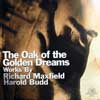 The truth regarding the history of minimalism and American experimentalmusic from the 60s is, despite the best efforts of certainmusicologists and writers, becoming much more widely know. As it does,more and more labels get in on the game of releasing the archivalrecordings that document the history better that any text can. Thesetwo CDs are part of this revisionism. Maxfield was older than most ofthe 60s pioneers; he had his grounding in the academy, ambitions ofbeing a composer of serious music, and access to the space and musicianresources of the classical world. He was pretty much ready to roll whenCage hit the scene. But his music, as presented here in these fourworks from 1960 to 63, is immediate, effective and without the need oftheoretical crutches. Each of these pieces can be seen as inventiveAmerican responses to develoments in the European avant-garde: Pastoral Symphonyto 18's electronic music but with the major difference of having beencontinuously synthesized (on which synth I wonder?) rather than splicedtogether; Bacchanale to Schaeffer's and Henry's musique concrète here incorporating beat poetry, jazz and narrative; Piano Concert for David Tudor, combining tape music with live piano, to Stockhausen's Kontakte (1960 version) with similarly unexpected and dramatic results; and finally Amazing Grace,based as it is on repetitive tape loops, being the most intrinsicallyAmerican of all. Maxfield's valuable and underrated work was ended in1969 when he died, a casualty of 60s drug culture. Harold Budd's musicis much less to my taste. I never put much effort into exploring hismusic since none of it ever caught my fancy but Budd's place in theworld of ambient and spiritualized meditative music is obviously one ofintegrity. The Oak of the Golden Dreams catches Buddimprovising bagpipe music on the Buchla synth in 1970, a twiddley modalchanter line over a continuous E flat drone (but it's probably relevantthat I grew up in Scotland to hate bagpipes). Coeur D'Orr hasessentially the same structure: two organ chords, D flat major on theright channel and B major on the left, sit there shimmering andswelling while Charles Oreña noodles a highly expressionist and attimes decidedly jazzy (Coltrane rather than Paul Desmond) line on thesoprano sax. Initially (the sax only comes in in the third minute) theresemblance to Charlemagne Palestine's organ music is obvious. But herethe organ is static and not central, functioning as a bed for melodicimprovisation within the static harmonic sound shape. Thecorrespondence to, say, Frank Zappa's guitar noodling within staticstructures, e.g. 'Ship Ahoy', is more accurate. Such overtly happy(hippy?) music isn't my bag but if you dig Budd these are surely twoimportant documents.
The truth regarding the history of minimalism and American experimentalmusic from the 60s is, despite the best efforts of certainmusicologists and writers, becoming much more widely know. As it does,more and more labels get in on the game of releasing the archivalrecordings that document the history better that any text can. Thesetwo CDs are part of this revisionism. Maxfield was older than most ofthe 60s pioneers; he had his grounding in the academy, ambitions ofbeing a composer of serious music, and access to the space and musicianresources of the classical world. He was pretty much ready to roll whenCage hit the scene. But his music, as presented here in these fourworks from 1960 to 63, is immediate, effective and without the need oftheoretical crutches. Each of these pieces can be seen as inventiveAmerican responses to develoments in the European avant-garde: Pastoral Symphonyto 18's electronic music but with the major difference of having beencontinuously synthesized (on which synth I wonder?) rather than splicedtogether; Bacchanale to Schaeffer's and Henry's musique concrète here incorporating beat poetry, jazz and narrative; Piano Concert for David Tudor, combining tape music with live piano, to Stockhausen's Kontakte (1960 version) with similarly unexpected and dramatic results; and finally Amazing Grace,based as it is on repetitive tape loops, being the most intrinsicallyAmerican of all. Maxfield's valuable and underrated work was ended in1969 when he died, a casualty of 60s drug culture. Harold Budd's musicis much less to my taste. I never put much effort into exploring hismusic since none of it ever caught my fancy but Budd's place in theworld of ambient and spiritualized meditative music is obviously one ofintegrity. The Oak of the Golden Dreams catches Buddimprovising bagpipe music on the Buchla synth in 1970, a twiddley modalchanter line over a continuous E flat drone (but it's probably relevantthat I grew up in Scotland to hate bagpipes). Coeur D'Orr hasessentially the same structure: two organ chords, D flat major on theright channel and B major on the left, sit there shimmering andswelling while Charles Oreña noodles a highly expressionist and attimes decidedly jazzy (Coltrane rather than Paul Desmond) line on thesoprano sax. Initially (the sax only comes in in the third minute) theresemblance to Charlemagne Palestine's organ music is obvious. But herethe organ is static and not central, functioning as a bed for melodicimprovisation within the static harmonic sound shape. Thecorrespondence to, say, Frank Zappa's guitar noodling within staticstructures, e.g. 'Ship Ahoy', is more accurate. Such overtly happy(hippy?) music isn't my bag but if you dig Budd these are surely twoimportant documents.  Andso to the Palestine CD which presents five slices of his electronicdrone music recorded between 1967 and 1970. Palestine's innatepredilection for evolving static sounds, transcendental drones andspiritual elevation was evident well before he first had access to thesynthesizers that allowed real-time manipulation of additive (combiningdifferent tones) and subtractive (filtering) synthesis. Thepossibilities for improvised drone music were obvious and he eventuallyhad a custom machine built for this purpose with 16 ultra-stableoscillators from Serge Tcherepnin and 4 band pass filters from DonaldBuchla. The five pieces here, all subtitled Late Night Electronic Sonority,are snapshots from his "spectral continuum searches for the goldensonority—day, week, month long journeys of harmonies and theirovertones in constant evolution in time and transformation in space."The music is heavy with tension, balanced somewhere between fear,existential question and the possibility of hope; glistening,shimmering and perfectly judged. It's a remarkable achievement thatPalestine originated this approach to music, the instrument design andits musical practice, performed these masterful improvisations,inspired a whole generation of musicians and wound up as a merefootnote, if that, in the history of minimalism. Take those PhillipGlass and John Adams disks down to the thrift store and get abordminimalism's revisionist revolution; apart from being more authentic,the real stuff is of infinitely superior taste and actually has a soul.
Andso to the Palestine CD which presents five slices of his electronicdrone music recorded between 1967 and 1970. Palestine's innatepredilection for evolving static sounds, transcendental drones andspiritual elevation was evident well before he first had access to thesynthesizers that allowed real-time manipulation of additive (combiningdifferent tones) and subtractive (filtering) synthesis. Thepossibilities for improvised drone music were obvious and he eventuallyhad a custom machine built for this purpose with 16 ultra-stableoscillators from Serge Tcherepnin and 4 band pass filters from DonaldBuchla. The five pieces here, all subtitled Late Night Electronic Sonority,are snapshots from his "spectral continuum searches for the goldensonority—day, week, month long journeys of harmonies and theirovertones in constant evolution in time and transformation in space."The music is heavy with tension, balanced somewhere between fear,existential question and the possibility of hope; glistening,shimmering and perfectly judged. It's a remarkable achievement thatPalestine originated this approach to music, the instrument design andits musical practice, performed these masterful improvisations,inspired a whole generation of musicians and wound up as a merefootnote, if that, in the history of minimalism. Take those PhillipGlass and John Adams disks down to the thrift store and get abordminimalism's revisionist revolution; apart from being more authentic,the real stuff is of infinitely superior taste and actually has a soul.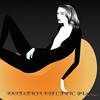 Following up an EP released a couple years back, Stereolab bassistSimon Johns has assembled the first full-length from his project. Theband consists of fantastic players, utilizing a wide spectrum ofinstruments and honing a driving sound most Stereolab fans could easilylatch on to. However, as I enjoyed the brevity of the other EP, as anLP, there's simply something missing. While the music is pleasant andenjoyable, most of the songs don't really progress far from their entrypoint. In addition, with the lack of melodic variety and the frequentdroning of single note playing, all the tracks makes this ensemblesound almost too "jam-band-y" for my own personal tastes. For the mostpart, it never quite gets offensive, that is until the "Theme for anImitation Electric Piano," with the atrocious "Rockin' and rollin' /the theme for an imitation electric piano" lyrics. Getting through theentire album just isn't as rewarding as a short 5-track EP of stuffthat gets in late and gets out early. If the eponymous EP gave thefeeling of a tap, slap, and run, Trinity Neon is a wait, get impatient and give up kinda feel, which, at best can serve as decent aural wallpaper.
Following up an EP released a couple years back, Stereolab bassistSimon Johns has assembled the first full-length from his project. Theband consists of fantastic players, utilizing a wide spectrum ofinstruments and honing a driving sound most Stereolab fans could easilylatch on to. However, as I enjoyed the brevity of the other EP, as anLP, there's simply something missing. While the music is pleasant andenjoyable, most of the songs don't really progress far from their entrypoint. In addition, with the lack of melodic variety and the frequentdroning of single note playing, all the tracks makes this ensemblesound almost too "jam-band-y" for my own personal tastes. For the mostpart, it never quite gets offensive, that is until the "Theme for anImitation Electric Piano," with the atrocious "Rockin' and rollin' /the theme for an imitation electric piano" lyrics. Getting through theentire album just isn't as rewarding as a short 5-track EP of stuffthat gets in late and gets out early. If the eponymous EP gave thefeeling of a tap, slap, and run, Trinity Neon is a wait, get impatient and give up kinda feel, which, at best can serve as decent aural wallpaper.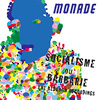 The first exposure to the lead singer of Stereolab, Laetitia Sadier's solo project Monade came on a split single with M (later known as Aerial M and currently Papa M). The music was unobtrusive, peaceful, and serene, much unlike the intense sounds Stereolab were notorious for. Finding Monade music was always a treat, whether it was on an obscure 7" single or a split release.
The first exposure to the lead singer of Stereolab, Laetitia Sadier's solo project Monade came on a split single with M (later known as Aerial M and currently Papa M). The music was unobtrusive, peaceful, and serene, much unlike the intense sounds Stereolab were notorious for. Finding Monade music was always a treat, whether it was on an obscure 7" single or a split release.
 Touted by just about every publication as being one of the next bestthings, The Stratford 4 leave a lot to be desired on this, their secondfull-length. Equally influenced it seems by My Bloody Valentine, TheCure, and scores of Brit-pop bands, their music is delayed anddistorted guitars with a pop sensibility. Officially, I would like tosay that this sound is going to take them absolutely nowhere unlessthey can improve the juvenile lyric-writing. The music is just fine,imploring pleasant melodies, grooving basslines, and lots of effectsthat make the guitars swirl and shriek behind them. Unfortunately, whatcomes to the forefront is just plain awful. "I went to confession but Ihad nothing to confess. They said what's wrong with you? You're usuallysuch a mess" is almost as bad as "If you want to kiss my mouth, tell mewhat it's all about, if you want to climb into bed with your delicatehead than that would be alright." This is a study in how to write likeDamon Albarn, with a great sense at times of what good music is, but nograsp whatsoever of poetry or prose. This music could stand a bit ofvariation, too, as it seems every song says what it's supposed to inthe first three minutes, then jams out a bit for the rest; or it jams abit in the beginning to build to the proper idea, then soars outtowards the end. The first song on the album, "Where the Ocean Meetsthe Eye," is the only one that shows promise in this sound, with quietbass joining chiming delayed guitars and slightly echoed drums. It allgets engulfed as the flames of loud angry distortion grow higher andhigher. The vocals join in at the height of the volume, and the lyricsare wailed in such a way that they aren't always recognizable. Perfect.Let the music talk and let the lyrics be puzzled over. If they'd donethat more, it probably wouldn't be so bad.
Touted by just about every publication as being one of the next bestthings, The Stratford 4 leave a lot to be desired on this, their secondfull-length. Equally influenced it seems by My Bloody Valentine, TheCure, and scores of Brit-pop bands, their music is delayed anddistorted guitars with a pop sensibility. Officially, I would like tosay that this sound is going to take them absolutely nowhere unlessthey can improve the juvenile lyric-writing. The music is just fine,imploring pleasant melodies, grooving basslines, and lots of effectsthat make the guitars swirl and shriek behind them. Unfortunately, whatcomes to the forefront is just plain awful. "I went to confession but Ihad nothing to confess. They said what's wrong with you? You're usuallysuch a mess" is almost as bad as "If you want to kiss my mouth, tell mewhat it's all about, if you want to climb into bed with your delicatehead than that would be alright." This is a study in how to write likeDamon Albarn, with a great sense at times of what good music is, but nograsp whatsoever of poetry or prose. This music could stand a bit ofvariation, too, as it seems every song says what it's supposed to inthe first three minutes, then jams out a bit for the rest; or it jams abit in the beginning to build to the proper idea, then soars outtowards the end. The first song on the album, "Where the Ocean Meetsthe Eye," is the only one that shows promise in this sound, with quietbass joining chiming delayed guitars and slightly echoed drums. It allgets engulfed as the flames of loud angry distortion grow higher andhigher. The vocals join in at the height of the volume, and the lyricsare wailed in such a way that they aren't always recognizable. Perfect.Let the music talk and let the lyrics be puzzled over. If they'd donethat more, it probably wouldn't be so bad.  The alternative country sound seems to get no respect anymore, as itnever really achieved any of the goals it was going for. There arepublications dedicated to it, sure, and records come out all the timefor its stalwarts like Ryan Adams and the Jayhawks; but alt-country, asit is often called, never revolutionized country music, and its artistsare still not widely recognized by mainstream country. With theexception of bands like Nickel Creek doing a Stephen Malkmus song ontheir last album or Johnny Cash doing Soundgarden or Nine Inch Nails,it also seems to have lost some of its alternative edge. That's allabout to change with the arrival of Kathleen Edwards. For me, thepinnacle of the alt-country sound was Whiskeytown, the band Ryan Adamshad with Caitlin Cary until 2000. They had it all: beautiful harmonies,great hooks, and songs about booze and heartache. Edwards continuestheir sound on the first song on Failer,then promptly blows it the hell away. She even plays violin, like Carydid in Whiskeytown, adding a sadness or playfulness to certain songs,just to get the right feeling in the right place. Her sound is at onceclassic and new, her voice is assured and insecure, the songs perfectand uneven. She's also quite aware of the difficulties of selling hersound, as she states nicely in "One More Song the Radio Won't Like,"and on songs like "Six O'Clock News" and "Hockey Skates" you wonder whythe mainstream press won't just eat it up at the same time that youhope they won't. Even though there seems to be a preoccupation withbooze and bars in her music, they're not bad things for a country starto be singing about, though it seems there are more weaknesses Edwardscould be exploring. She hints at big ones in small mentions, aboutbabies coming in June, and how she can't seem to do anything right.Every time it comes right back to tipping a glass/bottle or, on onesong at least, getting high. Mostly, though, the whole album has a feelabout getting out. Maybe Edwards will break out with this record, but Ihope she doesn't lose sight of this desperation and sadness. It's worthmuch more even it means no one will hear it.
The alternative country sound seems to get no respect anymore, as itnever really achieved any of the goals it was going for. There arepublications dedicated to it, sure, and records come out all the timefor its stalwarts like Ryan Adams and the Jayhawks; but alt-country, asit is often called, never revolutionized country music, and its artistsare still not widely recognized by mainstream country. With theexception of bands like Nickel Creek doing a Stephen Malkmus song ontheir last album or Johnny Cash doing Soundgarden or Nine Inch Nails,it also seems to have lost some of its alternative edge. That's allabout to change with the arrival of Kathleen Edwards. For me, thepinnacle of the alt-country sound was Whiskeytown, the band Ryan Adamshad with Caitlin Cary until 2000. They had it all: beautiful harmonies,great hooks, and songs about booze and heartache. Edwards continuestheir sound on the first song on Failer,then promptly blows it the hell away. She even plays violin, like Carydid in Whiskeytown, adding a sadness or playfulness to certain songs,just to get the right feeling in the right place. Her sound is at onceclassic and new, her voice is assured and insecure, the songs perfectand uneven. She's also quite aware of the difficulties of selling hersound, as she states nicely in "One More Song the Radio Won't Like,"and on songs like "Six O'Clock News" and "Hockey Skates" you wonder whythe mainstream press won't just eat it up at the same time that youhope they won't. Even though there seems to be a preoccupation withbooze and bars in her music, they're not bad things for a country starto be singing about, though it seems there are more weaknesses Edwardscould be exploring. She hints at big ones in small mentions, aboutbabies coming in June, and how she can't seem to do anything right.Every time it comes right back to tipping a glass/bottle or, on onesong at least, getting high. Mostly, though, the whole album has a feelabout getting out. Maybe Edwards will break out with this record, but Ihope she doesn't lose sight of this desperation and sadness. It's worthmuch more even it means no one will hear it.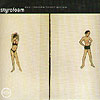 It's quite strange to imagine that there could now very well be ageneration of electronic-based musicians/artists who never sat forhours practicing scales, modes, chords, rhythms, what have you, on anactual instrument. Since the laptop revolution has brought aboutpractically every instrumental sound under the sun for consumption,there's not really a great need to sit with a chunk of wood or brass.Not that I don't favor electronic-based music or the musicians who makeit, but hearing additional sounds that were actually in the ether atsome point before being committed to tape (sorry, hard disk) makes fora refreshing change now and again. I'm What's There to Show That Something's Missing,the latest release from Belgian native Arne van Petegem (aka Styrofoam)enjoyably blends the glitch-type Powerbook beats and sounds with thelive element of prominent vocals and acoustic guitar at times for aninteresting take on modern pop music. "The Long Wait" opens the discwith the arpeggiations of said guitar and builds into a laid backgroove of electronic beats and keyboards that gradually thickens withsome synth bass while van Petegem's lush vocal layers deliver both acatchy melody and lyrics. The more pop-oriented "A Heart Without AMind" skips along to a wall of synth flourishes with the bass line andvocals leading the progressions until guitar and keyboards take over.The opening tape shuttle sounds of the more electronic "Forever, YouSaid Forever" drop out for some sparse keyboards and linear drummachine rhythms to provide the backing track for a sampled conversationof a couple that are in the midst of an arguement over a break-up. Thedisc's eight tunes are well crafted and arranged to highlight vanPetegem's skills as both a programmer and guitar player/vocalist byaugmenting the former with the latter. While this particular formulafor the laptop set is nothing new, Styrofoam's take on it makes for amore animated disc with the likeness of a full band.
It's quite strange to imagine that there could now very well be ageneration of electronic-based musicians/artists who never sat forhours practicing scales, modes, chords, rhythms, what have you, on anactual instrument. Since the laptop revolution has brought aboutpractically every instrumental sound under the sun for consumption,there's not really a great need to sit with a chunk of wood or brass.Not that I don't favor electronic-based music or the musicians who makeit, but hearing additional sounds that were actually in the ether atsome point before being committed to tape (sorry, hard disk) makes fora refreshing change now and again. I'm What's There to Show That Something's Missing,the latest release from Belgian native Arne van Petegem (aka Styrofoam)enjoyably blends the glitch-type Powerbook beats and sounds with thelive element of prominent vocals and acoustic guitar at times for aninteresting take on modern pop music. "The Long Wait" opens the discwith the arpeggiations of said guitar and builds into a laid backgroove of electronic beats and keyboards that gradually thickens withsome synth bass while van Petegem's lush vocal layers deliver both acatchy melody and lyrics. The more pop-oriented "A Heart Without AMind" skips along to a wall of synth flourishes with the bass line andvocals leading the progressions until guitar and keyboards take over.The opening tape shuttle sounds of the more electronic "Forever, YouSaid Forever" drop out for some sparse keyboards and linear drummachine rhythms to provide the backing track for a sampled conversationof a couple that are in the midst of an arguement over a break-up. Thedisc's eight tunes are well crafted and arranged to highlight vanPetegem's skills as both a programmer and guitar player/vocalist byaugmenting the former with the latter. While this particular formulafor the laptop set is nothing new, Styrofoam's take on it makes for amore animated disc with the likeness of a full band. There's a long list of albums with titles that are misnomers for the music inside. With Summer Sun,Yo La Tengo are pretty close to adding another to the list. Severaltracks interspersed save the album from this category by shining alittle light in, though the band generally gets mired in theirexquisitely somber sound, which is a very good thing. Album afteralbum, Yo La Tengo produce quality music with impressive productionvalues, and this album is no different. The proceedings start, as morethan one Yo La Tengo album has, with an instrumental of sorts, and"Beach Party Tonight" is a clear indication that the electronic side ispossessing the band more and more on each release. The whole albumfeatures more technology, and these additions lend a lot to the generalaura of the music without being intrusive. Ira Kaplan's vocals arefrequently hushed, as usual, and on "Beach Party," they're almostincomprehensible, bringing the music to the forefront. Georgia Hubleyis coming into her own vocally, sounding more and more like thechanteuse that's been hiding away. "Little Eyes" is a perfect power popproduction, much like the more mainstream fair of I Can Hear the Heart Beating as One.Elsewhere the tradition of one epic song per album continues, too, with"Let's Be Still" as this album's "Night Falls on Hoboken," and it's abit more coherent and a bit more freeform than before. One thing thatthe title suggests clearly, though, is that Yo La Tengo were out tohave a lot more fun this time, and it shows on tracks like "Georgia vs.Yo La Tengo," an almost '70s porn anthem laden with effects and funkpiano, and on "Winter A-Go-Go", which could almost pass for Steve andEydie. Even though there's more sun in the sky, there's always shadowscast, and that's what they thankfully couldn't avoid. Summer Sunis not their best work, but it is another solid album from a band notafraid to expand their sound, take chances or let loose every now andthen.
There's a long list of albums with titles that are misnomers for the music inside. With Summer Sun,Yo La Tengo are pretty close to adding another to the list. Severaltracks interspersed save the album from this category by shining alittle light in, though the band generally gets mired in theirexquisitely somber sound, which is a very good thing. Album afteralbum, Yo La Tengo produce quality music with impressive productionvalues, and this album is no different. The proceedings start, as morethan one Yo La Tengo album has, with an instrumental of sorts, and"Beach Party Tonight" is a clear indication that the electronic side ispossessing the band more and more on each release. The whole albumfeatures more technology, and these additions lend a lot to the generalaura of the music without being intrusive. Ira Kaplan's vocals arefrequently hushed, as usual, and on "Beach Party," they're almostincomprehensible, bringing the music to the forefront. Georgia Hubleyis coming into her own vocally, sounding more and more like thechanteuse that's been hiding away. "Little Eyes" is a perfect power popproduction, much like the more mainstream fair of I Can Hear the Heart Beating as One.Elsewhere the tradition of one epic song per album continues, too, with"Let's Be Still" as this album's "Night Falls on Hoboken," and it's abit more coherent and a bit more freeform than before. One thing thatthe title suggests clearly, though, is that Yo La Tengo were out tohave a lot more fun this time, and it shows on tracks like "Georgia vs.Yo La Tengo," an almost '70s porn anthem laden with effects and funkpiano, and on "Winter A-Go-Go", which could almost pass for Steve andEydie. Even though there's more sun in the sky, there's always shadowscast, and that's what they thankfully couldn't avoid. Summer Sunis not their best work, but it is another solid album from a band notafraid to expand their sound, take chances or let loose every now andthen.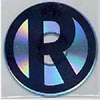 Replicator are a neat dynamic rock trio from the San Francisco Bay Area who get compared to Shellac a lot. This seems to be mostly because Shellac bassist Bob Weston records them and because they are quite vocal on the Shellac email list, which is how I happened to hear about them. To me a much better comparison would be Poster Children, but imagine how they might have ended up had they introduced the loops and synths of Salaryman into their exuberant rockpop shapes instead of separating into two different projects involving the same people.
Replicator are a neat dynamic rock trio from the San Francisco Bay Area who get compared to Shellac a lot. This seems to be mostly because Shellac bassist Bob Weston records them and because they are quite vocal on the Shellac email list, which is how I happened to hear about them. To me a much better comparison would be Poster Children, but imagine how they might have ended up had they introduced the loops and synths of Salaryman into their exuberant rockpop shapes instead of separating into two different projects involving the same people.
 Lately it seems Mark Eitzel has just been taking opportunities as they come. He was invited to record albums in Chicago and Athens, served a month long residency at the Knitting Factory in NYC and will soon tour Portugal and Spain. 'The Ugly American' is the result of the trip to Greece and the debut album from the UK's Tongue Master (a U.S. release date is likely for June or July via Thirsty Ear).
Lately it seems Mark Eitzel has just been taking opportunities as they come. He was invited to record albums in Chicago and Athens, served a month long residency at the Knitting Factory in NYC and will soon tour Portugal and Spain. 'The Ugly American' is the result of the trip to Greece and the debut album from the UK's Tongue Master (a U.S. release date is likely for June or July via Thirsty Ear).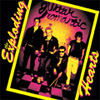 The Exploding Hearts are unabashed disciples of the vibrant,inescapably catchy power pop of bands like The Knack and The Nerves.Mixing the thrust of early punk with the melodic sensibilities ofsixties results in a spirited, irresistible product with a sharp edge.It's evident throughout Guitar Romantic that it isn't a pose, nor is it a joke. These are guys who are on their third or fourth copy of Singles Going Steadycause they wore them out, who wondered what Brian Wilson might havesounded like if he met up with Richard Hell, who know the value of agood, steady finger snap and aren't afraid to use it. This is the musicthey love and it is that passion that makes Guitar Romanticsuch an engaging listen. Don't think that because they pay homage to somany of their influences that there is nothing new on this record. Infact, the Exploding Hearts bring a ferocious energy to their sound,charging headfirst into a crunchy rocker, or soulfully crooning alongwith a backup harmony. "Modern Kicks" opens things up, digging rightin, and guaranteeing that you'll stick around for the rest of album.The lead guitar slices through the fuzzed out production that causesthe instruments to blur and rattle around each other. The mix gives adirty, vintage sound that adds to the personality of the music. Itsounds as if the album had slipped behind a shelf or under a pile ofrecords twenty years ago, only to be rediscovered today as a lost popgem. The bright shuffle of "Sleeping Aids and Razorblades" carries theHearts' soulful romantic persona with clever lyrics like "it's a littleupbeat / and it ain't in tune / you know it's just like this heart ofmine." That line could serve as the tagline for Guitar Romantic,as the Hearts cover the trials and troubles of teenage romance with theresiliently forlorn attitude they deserve, all packaged in a blissfullysweet pop delivery. "Jailbird," a love song about sniffing glue, has adevastatingly hooky chorus, amplified by the call and response backupvocals and a 120 watt guitar melody. You'll find yourself followingalong with every "Yeah, Yeah" and "Woah, Woah." There truly is not aweak song on the entire album. Each track is irresistibly catchy andafter a brief ten songs in twenty-eight minutes, the desire for anotherfix is intense. Guitar Romantic could have easily become justanother nostalgia act looking to knock off the past, but this is farfrom the case. They bring their own tack to a familiar style, imbuingit with a newfound youth and soul. The energy and vitality that theExploding Hearts put out is stunning, their music finely crafted topound even the most jaded music fan into grinning, head bouncingsubmission.
The Exploding Hearts are unabashed disciples of the vibrant,inescapably catchy power pop of bands like The Knack and The Nerves.Mixing the thrust of early punk with the melodic sensibilities ofsixties results in a spirited, irresistible product with a sharp edge.It's evident throughout Guitar Romantic that it isn't a pose, nor is it a joke. These are guys who are on their third or fourth copy of Singles Going Steadycause they wore them out, who wondered what Brian Wilson might havesounded like if he met up with Richard Hell, who know the value of agood, steady finger snap and aren't afraid to use it. This is the musicthey love and it is that passion that makes Guitar Romanticsuch an engaging listen. Don't think that because they pay homage to somany of their influences that there is nothing new on this record. Infact, the Exploding Hearts bring a ferocious energy to their sound,charging headfirst into a crunchy rocker, or soulfully crooning alongwith a backup harmony. "Modern Kicks" opens things up, digging rightin, and guaranteeing that you'll stick around for the rest of album.The lead guitar slices through the fuzzed out production that causesthe instruments to blur and rattle around each other. The mix gives adirty, vintage sound that adds to the personality of the music. Itsounds as if the album had slipped behind a shelf or under a pile ofrecords twenty years ago, only to be rediscovered today as a lost popgem. The bright shuffle of "Sleeping Aids and Razorblades" carries theHearts' soulful romantic persona with clever lyrics like "it's a littleupbeat / and it ain't in tune / you know it's just like this heart ofmine." That line could serve as the tagline for Guitar Romantic,as the Hearts cover the trials and troubles of teenage romance with theresiliently forlorn attitude they deserve, all packaged in a blissfullysweet pop delivery. "Jailbird," a love song about sniffing glue, has adevastatingly hooky chorus, amplified by the call and response backupvocals and a 120 watt guitar melody. You'll find yourself followingalong with every "Yeah, Yeah" and "Woah, Woah." There truly is not aweak song on the entire album. Each track is irresistibly catchy andafter a brief ten songs in twenty-eight minutes, the desire for anotherfix is intense. Guitar Romantic could have easily become justanother nostalgia act looking to knock off the past, but this is farfrom the case. They bring their own tack to a familiar style, imbuingit with a newfound youth and soul. The energy and vitality that theExploding Hearts put out is stunning, their music finely crafted topound even the most jaded music fan into grinning, head bouncingsubmission. 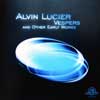 These five Lucier pieces dating from 1961 to 1970 provide handyillustrations of my love-hate relationship with American academicmusic. Its central Theory versus Music dialectic is interesting. Is thetheory on which music is based important? If so, to whom? If a CD makesno sense aesthetically or otherwise until the liner notes are read (andthe liner notes are in this elevated domain unquestionably important)what does that say about the music? Does the pleasure of listeningdepend on the theory or should the pleasure be sought in the theoryitself? The first illustration on this CD is "Vespers" (1969) whichinvolves performers moving around a given acoustic space withdirectional pulse generators. I liked the piece before I read the notesbut I find it makes even more interesting listening how that I have.The piece demonstrates the theory that humans perceive physical spacethrough our sense of hearing. Without the theory, it's fifteen minutesof attractive clicking sounds but with the theory the listener becomesconsciously involved by providing and operating the apparatus for theperceptual half of the experiment, which can lead to deeperunderstanding and pleasure—it's rather like having impressionistpainting explained to you for the first time. Implication: theory canenhance music. "Chambers" (1968) illustrates another point; beforereading my response was: sounds okay, nice enough. It involves variousrecordings of sound spaces, such as a railway station, cafeteria orwhat-have-you, playing on portable devices, disguised in some kind ofwrapping, that are placed within the performance sound space—thuschambers (i.e. acoustic spaces) within chambers. Now that's fine andperhaps even witty, in a rather twee academic way, but grasping theconcept doesn't improve the listening experience and I'm beginning toget annoyed by the suggestion that the concept is even relevant to me.Implication: theory doesn't always enhance music and can detract. Onyet another hand, "North American Time Capsule" (1967), a performanceon the archaic Sylvania encrypting voice encoder without thecorresponding decoder, is unlistenable with or without the various deepand interesting levels of meaning provided by its associated theory.Implication: theory cannot enhance bad music. "(Middletown) MemorySpace" (1970) is scripted thus: a number of singers and/orinstrumentalists go out into a city and "record, by anymeans—electronic recording, graphic notation, or memory—the sounds ofthe city," return and "re-create, solely my means of your voices andinstruments and with the aid of memory devices (without additions,deletions, improvisation, interpretation) those outside soundsituations." On this performance the music sounds like rather dullimprov. Contemplating the composition (i.e. the instructions) providesa better distraction than the music: can it be done?; does it matter atall if it can't?; is the absurd impossibility of the parenthetical"without" clause another joke?; is this what group improv sounds likewhen exerting personality and thus interaction is explicitlyforbidden?; what must it be like to be paid to think about thesethings? And there we have, I fear, the crucible of my irritation:jealousy. These Cagian exercises must surely be great fun for thecomposer and may even be pleasing for the performers but the disregardfor whether or not the music will be any good to listen to is a littleirksome to the mere audience member. The implication is that composingand being a composer is more important than being a listener, eventhough the former is existentially dependent on the latter (composingfor its own sake has little to do with music). Such elitism isjustifiable and I am thankful for it when the resulting art is good andvaluable. But when it is not, which is not the exceptional case inAmerican academic music, I find that I cannot discard it without envy.
These five Lucier pieces dating from 1961 to 1970 provide handyillustrations of my love-hate relationship with American academicmusic. Its central Theory versus Music dialectic is interesting. Is thetheory on which music is based important? If so, to whom? If a CD makesno sense aesthetically or otherwise until the liner notes are read (andthe liner notes are in this elevated domain unquestionably important)what does that say about the music? Does the pleasure of listeningdepend on the theory or should the pleasure be sought in the theoryitself? The first illustration on this CD is "Vespers" (1969) whichinvolves performers moving around a given acoustic space withdirectional pulse generators. I liked the piece before I read the notesbut I find it makes even more interesting listening how that I have.The piece demonstrates the theory that humans perceive physical spacethrough our sense of hearing. Without the theory, it's fifteen minutesof attractive clicking sounds but with the theory the listener becomesconsciously involved by providing and operating the apparatus for theperceptual half of the experiment, which can lead to deeperunderstanding and pleasure—it's rather like having impressionistpainting explained to you for the first time. Implication: theory canenhance music. "Chambers" (1968) illustrates another point; beforereading my response was: sounds okay, nice enough. It involves variousrecordings of sound spaces, such as a railway station, cafeteria orwhat-have-you, playing on portable devices, disguised in some kind ofwrapping, that are placed within the performance sound space—thuschambers (i.e. acoustic spaces) within chambers. Now that's fine andperhaps even witty, in a rather twee academic way, but grasping theconcept doesn't improve the listening experience and I'm beginning toget annoyed by the suggestion that the concept is even relevant to me.Implication: theory doesn't always enhance music and can detract. Onyet another hand, "North American Time Capsule" (1967), a performanceon the archaic Sylvania encrypting voice encoder without thecorresponding decoder, is unlistenable with or without the various deepand interesting levels of meaning provided by its associated theory.Implication: theory cannot enhance bad music. "(Middletown) MemorySpace" (1970) is scripted thus: a number of singers and/orinstrumentalists go out into a city and "record, by anymeans—electronic recording, graphic notation, or memory—the sounds ofthe city," return and "re-create, solely my means of your voices andinstruments and with the aid of memory devices (without additions,deletions, improvisation, interpretation) those outside soundsituations." On this performance the music sounds like rather dullimprov. Contemplating the composition (i.e. the instructions) providesa better distraction than the music: can it be done?; does it matter atall if it can't?; is the absurd impossibility of the parenthetical"without" clause another joke?; is this what group improv sounds likewhen exerting personality and thus interaction is explicitlyforbidden?; what must it be like to be paid to think about thesethings? And there we have, I fear, the crucible of my irritation:jealousy. These Cagian exercises must surely be great fun for thecomposer and may even be pleasing for the performers but the disregardfor whether or not the music will be any good to listen to is a littleirksome to the mere audience member. The implication is that composingand being a composer is more important than being a listener, eventhough the former is existentially dependent on the latter (composingfor its own sake has little to do with music). Such elitism isjustifiable and I am thankful for it when the resulting art is good andvaluable. But when it is not, which is not the exceptional case inAmerican academic music, I find that I cannot discard it without envy. 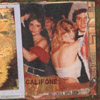 This is proof that a band can combine a number of different musicalgenres into an album and still have it be as beautiful as it isinteresting. Country and folk roots, good ol' fashioned rock, blues,and sound collages all fit together quite nicely and summon spiritsboth old and new with outstanding results. Califone's Quicksand/Cradlesnakesdoesn't have a single wasted note on it. Electric and acousticinstrumentation fit together like pieces of a musical puzzle few othershave been able to solve; tape loops of broken, stringed instruments,computer beeps and bloops, and spiraling machine noise slideeffortlessly into and alongside country-tinged ballads full oflamenting pianos and dancing guitars. A perfect example of this lovelycombination is "Horoscopic.Amputation.Honey.," where buzzing guitarsshift in and out of mix that includes wooden, rattling percussion, whatsounds like a type-writer, and twangy acoustic guitar. Tim Rutili'svoice plays a big part in the music, too. At times his voice is sweetand soft like a lullaby and elsewhere it is bold and full of attitude.The rebellious and edgey "Your Golden Ass" is full spicey vocals,surreal lyrics, grimy guitar, and steel drums that somehow fit in witheverything else. The primitive and nervous "(Red)" makes me feel likeI'm in the middle of an almost-deserted and very dangerous townsomewhere in a vast desert and "When Leon Spinx Moved Into Town" is asexy, albeit quiet, rock tune blossoming with southern spices and atension that is hard to identify, but is looming and menacing in a verysinister way. The entire album is lavished with images and emotionsthat leave no room for dull moments. Califone has given birth to onehell of a fine rock album; it is diverse, full of lovely songs, andjust plain fun to listen to.
This is proof that a band can combine a number of different musicalgenres into an album and still have it be as beautiful as it isinteresting. Country and folk roots, good ol' fashioned rock, blues,and sound collages all fit together quite nicely and summon spiritsboth old and new with outstanding results. Califone's Quicksand/Cradlesnakesdoesn't have a single wasted note on it. Electric and acousticinstrumentation fit together like pieces of a musical puzzle few othershave been able to solve; tape loops of broken, stringed instruments,computer beeps and bloops, and spiraling machine noise slideeffortlessly into and alongside country-tinged ballads full oflamenting pianos and dancing guitars. A perfect example of this lovelycombination is "Horoscopic.Amputation.Honey.," where buzzing guitarsshift in and out of mix that includes wooden, rattling percussion, whatsounds like a type-writer, and twangy acoustic guitar. Tim Rutili'svoice plays a big part in the music, too. At times his voice is sweetand soft like a lullaby and elsewhere it is bold and full of attitude.The rebellious and edgey "Your Golden Ass" is full spicey vocals,surreal lyrics, grimy guitar, and steel drums that somehow fit in witheverything else. The primitive and nervous "(Red)" makes me feel likeI'm in the middle of an almost-deserted and very dangerous townsomewhere in a vast desert and "When Leon Spinx Moved Into Town" is asexy, albeit quiet, rock tune blossoming with southern spices and atension that is hard to identify, but is looming and menacing in a verysinister way. The entire album is lavished with images and emotionsthat leave no room for dull moments. Califone has given birth to onehell of a fine rock album; it is diverse, full of lovely songs, andjust plain fun to listen to.  Occasionally there is a song which comes along that is so damnedexciting time just plain stops for three minutes and 14 seconds. Theexperience of hearing Sharon Jones' cover of Janet Jackson's "What HaveYou Done for Me Lately" on the local college radio waves has beenabsolutely maddening. Perhaps the novelty of a soul revival outfitdoing a 1980s cover tune in 1960s funk style was enough to get thissong noticed, but once it's heard, it's damned addictive. No matter ifI was stuck in traffic behind dildos on mobile phones or getting up andready for work, the world truly did feel like a great place to be whenthis song came on. Hearing the album in full now is nothing less than adivine reward. It's safe to say that the energy captured by Jones andthe Dap Kings througout the entire record is equally as feverish andunstoppable as the single, and after countless listens it's not losingone bit of the charm. Dap-Dippin'is the first full-length for NYC-based Daptone Records (founded in thewake of the demise of Desco records) and collects a number of the songsfrom various 7" singles released by Jones over the last couple years.Recently, the singles and albums seem to be popping up in bizarreplaces and catching on to those both curious and adventurous enough togive it a try, and rightfully so. The music is a fantastic tribute tothe untainted sound of years long gone, presented in living mono andskillfully produced with an ensemble of talented musicians to give it alive in-studio production feeling that bands HAD to get right backbefore multitracking was affordable. Jones, a former session vocalistand the singer occasionally known as Miss Lafaye, fronts the groupthrough ten songs of unchained vigor with the saucy attitude of themost famous funk frontmen and the seasoned grace of a lady who knowsher shit. The real leader however seems to be Bosco Mann, bassist forthe Sugarman 3 and probably a member of a number of Daptone (andformerly Desco) in-house bands. Dap-Dippin' tactfully has theelements which usually contractually made up a late 1960s vocal soulrecord, with the live clip for the introduction, the high energy hitsingles (like "Got a Thing on My Mind" and "Got to be the Way it Is,")the ballad ("Make it Good to Me") and the tunes with the instrumentalbreakdowns for the band to show off and the listeners to get down("Pick it Up, Lay it in the Cut"). I hate to admit that it may besomewhat formulaic but I will stand by my claim that it is undeniablyfun.
Occasionally there is a song which comes along that is so damnedexciting time just plain stops for three minutes and 14 seconds. Theexperience of hearing Sharon Jones' cover of Janet Jackson's "What HaveYou Done for Me Lately" on the local college radio waves has beenabsolutely maddening. Perhaps the novelty of a soul revival outfitdoing a 1980s cover tune in 1960s funk style was enough to get thissong noticed, but once it's heard, it's damned addictive. No matter ifI was stuck in traffic behind dildos on mobile phones or getting up andready for work, the world truly did feel like a great place to be whenthis song came on. Hearing the album in full now is nothing less than adivine reward. It's safe to say that the energy captured by Jones andthe Dap Kings througout the entire record is equally as feverish andunstoppable as the single, and after countless listens it's not losingone bit of the charm. Dap-Dippin'is the first full-length for NYC-based Daptone Records (founded in thewake of the demise of Desco records) and collects a number of the songsfrom various 7" singles released by Jones over the last couple years.Recently, the singles and albums seem to be popping up in bizarreplaces and catching on to those both curious and adventurous enough togive it a try, and rightfully so. The music is a fantastic tribute tothe untainted sound of years long gone, presented in living mono andskillfully produced with an ensemble of talented musicians to give it alive in-studio production feeling that bands HAD to get right backbefore multitracking was affordable. Jones, a former session vocalistand the singer occasionally known as Miss Lafaye, fronts the groupthrough ten songs of unchained vigor with the saucy attitude of themost famous funk frontmen and the seasoned grace of a lady who knowsher shit. The real leader however seems to be Bosco Mann, bassist forthe Sugarman 3 and probably a member of a number of Daptone (andformerly Desco) in-house bands. Dap-Dippin' tactfully has theelements which usually contractually made up a late 1960s vocal soulrecord, with the live clip for the introduction, the high energy hitsingles (like "Got a Thing on My Mind" and "Got to be the Way it Is,")the ballad ("Make it Good to Me") and the tunes with the instrumentalbreakdowns for the band to show off and the listeners to get down("Pick it Up, Lay it in the Cut"). I hate to admit that it may besomewhat formulaic but I will stand by my claim that it is undeniablyfun.  Armed with insomnia, a handful of members from the Godspeed family, and some egregiously long song titles, Set Fire To Flames oscillate only between dark minimalist music to moderately fleshed out instrumentals. Though Set Fire To Flames does not stimulate the same fiercely glorified feeling as Godspeed, they are able to elicit a more subtle response in some of their songs which has the potential to be no less rewarding. Most of the time, though, this sensation is a little more evasive, and the rewards a little more oblique.
Armed with insomnia, a handful of members from the Godspeed family, and some egregiously long song titles, Set Fire To Flames oscillate only between dark minimalist music to moderately fleshed out instrumentals. Though Set Fire To Flames does not stimulate the same fiercely glorified feeling as Godspeed, they are able to elicit a more subtle response in some of their songs which has the potential to be no less rewarding. Most of the time, though, this sensation is a little more evasive, and the rewards a little more oblique.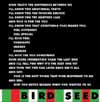 For over 20 years, William Bennett's infamous Whitehouse have remained on top of the power electronics game. While countless acts worldwide (particularly in Sweden and the U.S.) cannot seem to make the musical step past "Thank Your Lucky Stars," Whitehouse has evolved into a far more sinister entity with superior production quality.
For over 20 years, William Bennett's infamous Whitehouse have remained on top of the power electronics game. While countless acts worldwide (particularly in Sweden and the U.S.) cannot seem to make the musical step past "Thank Your Lucky Stars," Whitehouse has evolved into a far more sinister entity with superior production quality.


